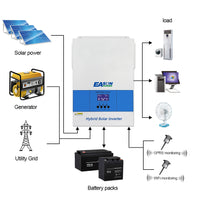Choosing the right solar PV charge controller for your energy needs is a crucial step in ensuring the efficiency and longevity of your solar power system. This guide will help you navigate the complexities of selecting the most suitable charge controller, providing you with the knowledge to make an informed decision.

Understanding Solar PV Charge Controllers
Solar PV charge controllers are essential components in any solar power system. They regulate the voltage and current coming from the solar panels to the batteries, preventing overcharging and ensuring optimal battery performance. There are two main types of charge controllers: Pulse Width Modulation (PWM) and Maximum Power Point Tracking (MPPT).
PWM vs. MPPT: Which One to Choose?
When choosing the right solar PV charge controller for your energy needs, it's important to understand the differences between PWM and MPPT controllers. PWM controllers are simpler and more affordable, making them suitable for smaller systems with lower power requirements. They work by gradually reducing the amount of power sent to the batteries as they approach full charge.
On the other hand, MPPT controllers are more advanced and efficient, especially in larger systems. They continuously track the maximum power point of the solar panels, adjusting the voltage and current to maximize energy harvest. This makes MPPT controllers ideal for systems with higher power demands and varying environmental conditions.
Factors to Consider When Choosing a Charge Controller
Several factors should be considered when selecting the right solar PV charge controller for your energy needs:
- System Voltage: Ensure the charge controller is compatible with the voltage of your solar power system, typically 12V, 24V, or 48V.
- Current Rating: The charge controller must handle the maximum current produced by your solar panels. Calculate this by dividing the total wattage of your panels by the system voltage.
- Temperature Compensation: Some charge controllers offer temperature compensation, adjusting the charging parameters based on the ambient temperature to protect your batteries.
- Load Control: If you plan to connect loads directly to the charge controller, ensure it has load control features to manage the power distribution effectively.
Innovative Features to Look For
Modern solar PV charge controllers come with various innovative features that can enhance the performance and convenience of your solar power system:
- Remote Monitoring: Some charge controllers offer remote monitoring capabilities, allowing you to track your system's performance via a smartphone app or web portal.
- Data Logging: Advanced controllers can log data on energy production and consumption, helping you analyze and optimize your system's efficiency.
- Multiple Charging Stages: Look for controllers with multiple charging stages (bulk, absorption, and float) to ensure your batteries are charged efficiently and safely.
Conclusion
Choosing the right solar PV charge controller for your energy needs is a vital step in optimizing your solar power system's performance. By understanding the differences between PWM and MPPT controllers, considering key factors, and looking for innovative features, you can make an informed decision that ensures the longevity and efficiency of your system.
Remember, the right charge controller not only protects your batteries but also maximizes the energy harvest from your solar panels, making your investment in renewable energy more rewarding. Happy solar harvesting!














